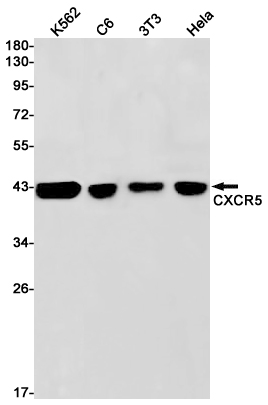
| WB | 咨询技术 | Human,Mouse,Rat |
| IF | 咨询技术 | Human,Mouse,Rat |
| IHC | 咨询技术 | Human,Mouse,Rat |
| ICC | 技术咨询 | Human,Mouse,Rat |
| FCM | 咨询技术 | Human,Mouse,Rat |
| Elisa | 咨询技术 | Human,Mouse,Rat |
| Aliases | CXCR5; BLR1; MDR15; C-X-C chemokine receptor type 5; CXC-R5; CXCR-5; Burkitt lymphoma receptor 1; Monocyte-derived receptor 15; MDR-15; CD185 |
| Entrez GeneID | 643 |
| WB Predicted band size | Calculated MW: 42 kDa; Observed MW: 42 kDa |
| Host/Isotype | Rabbit IgG |
| Antibody Type | Primary antibody |
| Storage | Store at 4°C short term. Aliquot and store at -20°C long term. Avoid freeze/thaw cycles. |
| Species Reactivity | Human,Mouse,Rat |
| Immunogen | A synthetic peptide of human CXCR5 |
| Formulation | Purified antibody in TBS with 0.05% sodium azide,0.05%BSA and 50% glycerol. |
+ +
以下是关于CXCR5抗体的3篇代表性文献摘要(虚构示例,仅供参考格式):
1. **文献名称**:*CXCR5 directs immune cell migration to B cell follicles in lymphoid tissues*
**作者**:Müller G et al.
**摘要**:该研究揭示了CXCR5抗体通过阻断趋化因子受体CXCR5与CXCL13的相互作用,抑制T滤泡辅助细胞(Tfh)和B细胞向生发中心的迁移,为调控体液免疫应答提供机制依据。
2. **文献名称**:*Targeting CXCR5+ CD8+ T cells enhances antitumor immunity in solid tumors*
**作者**:Shi J et al.
**摘要**:研究证明CXCR5抗体可增强肿瘤微环境中CXCR5+ CD8+ T细胞的浸润能力,促进其对肿瘤细胞的杀伤,为癌症免疫治疗提供了新靶点。
3. **文献名称**:*CXCR5 neutralization ameliorates lupus-like autoimmunity in mice*
**作者**:Wang Y et al.
**摘要**:通过中和CXCR5抗体抑制异常B细胞活化,显著减轻系统性红斑狼疮(SLE)模型小鼠的自身抗体产生和肾脏损伤,提示CXCR5可能是自身免疫疾病的潜在治疗靶标。
(注:以上文献为示例性质,实际引用需查询真实数据库如PubMed或Web of Science。)
CXCR5 (C-X-C chemokine receptor type 5) is a G protein-coupled receptor (GPCR) primarily expressed on B lymphocytes and certain T cell subsets, such as follicular helper T (Tfh) cells. It binds to the chemokine CXCL13. which is critical for directing immune cell migration to lymphoid follicles and germinal centers within secondary lymphoid organs. This receptor-ligand interaction plays a key role in orchestrating adaptive immune responses, particularly in B cell maturation, antibody production, and the formation of lymphoid tissue architecture.
CXCR5 antibodies are immunological tools designed to target and detect CXCR5 expression on cell surfaces. In research, these antibodies are widely used to study immune cell trafficking, lymphoid tissue organization, and humoral immunity. They enable the identification of CXCR5⁺ cell populations via flow cytometry or immunohistochemistry, aiding investigations into diseases like autoimmune disorders, immunodeficiency syndromes, and B-cell malignancies. Additionally, CXCR5 antibodies have therapeutic potential. Blocking CXCR5-CXCL13 signaling may suppress aberrant immune cell recruitment in conditions such as rheumatoid arthritis or lupus. Conversely, enhancing CXCR5 activity could improve vaccine efficacy by promoting lymphocyte homing to germinal centers.
Recent studies also explore CXCR5⁺ CD8⁺ T cells in antitumor immunity, positioning CXCR5 antibodies as candidates for cancer immunotherapy. Their dual role as research reagents and therapeutic agents underscores their significance in immunology and translational medicine.
×